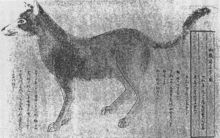Kanko or Kuda-gitsune (管狐, "pipe fox") is a creature supposedly employed by Japanese kitsune-tsukai, those who use foxes as spirit familiars.
Types
- In the Sozan Chomon Kishu ((想山著聞奇集) the kuda-gitsune is described as a rat-sized fox which can be kept in a pipe.
- According to the Zen'an Zuihitsu (善庵随筆) the kanko is a fox the size of a weasel or rat, with vertical eyes and thin hair. The magic-user summons the kanko to appear inside a bamboo pipe which he is holding, whereupon the fox will answer all the questions it is asked. The origin of this practice is traced back to a yamabushi who obtained this art while undergoing strict asceticism on Mount Kinpu. These Kanko are said to be numerous in the northern mountains of Suruga, Totomi, and Mikawa Provinces.
- Researcher Inoue Enryo in his Yokaigaku Kogi (?????, Yokaigaku Kogi?), quotes a newspaper article regarding the kanko, in which it is a tiny, mouse-sized creature which hails from Shinano Province. It is named for its tail, which is like a pipe cut in half. It can be tamed and kept in a pocket or sleeve, and uses its supernatural power to seek out assorted information which it then whispers to its master. A person who keeps it is thus able to see into both the past and future.
Art/Fiction
- In the handheld game Digimon Accelerator Ultimate Genome and Digimon Data Squad there is a kuda-gitsune Digimon called Kudamon.
- In Digimon Tamers, the fox-like Sakuyamon summons multiple kuda-gitsune to attack her enemies
- In the manga/anime series xxxHolic, Yuuko Ichihara receives a kuda-gitsune from the rain-spirit as payment for a favor.
- In the game Okami, tube fox monsters are used as the henchmen of the Nine-tails boss.
References
de Visser, M. W. (1908). "The Fox and the Badger in Japanese Folklore". Transactions of the Asiatic Society of Japan 36 (3): pp. 122-124. Z. P. Maruya & Co..

